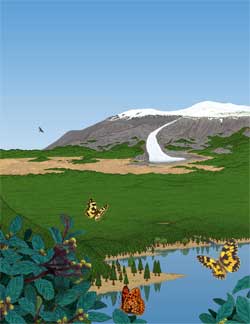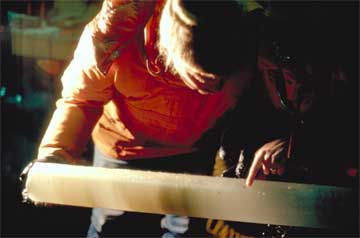Lush forests blanked Greenland 500,000 years ago
Lush forests blanked Greenland 500,000 years ago
mongabay.com
July 5, 2007
Rich boreal forests with butterflies and other insects flourished on Greenland within the past million years, reports a new study published in the July 6th issue of the journal Science.
Using DNA extracted from plants and insects embedded deep in ice cores scientists found evidence that Greenland, today a frozen island, was considerably warmer during the past 450,000 to 900,000 years than previously thought. Until now the youngest evidence of a boreal forest in Greenland dated from 2.4 million years ago.
“We have shown for the first time that southern Greenland, which is currently hidden under more than 2km of ice, was once very different to the Greenland we see today,” said Dr. Eske Willerslev, a professor at the University of Copenhagen who led the study. “Back then, it was inhabited by a diverse array of conifer trees and insects.”
 Image courtesy of the Wellcome Trust |
“These findings allow us to make a more accurate environmental reconstruction of the time period from which these samples were taken, and what we’ve learned is that this part of the world was significantly warmer than most people thought,” said Martin Sharp, a glaciologist at the University of Alberta and a co-author of the paper.
The researchers say that since fossils are not available in this part of Greenland, they instead relied on DNA that been preserved under two kilometers of ice for anywhere from 130,000 to one million years.
“The DNA samples suggest the temperature of the southern Greenland boreal forests 450,000 to 900,000 years-ago was probably between 10C in summer and -17C in winter,” explained a release from the University of Alberta. “The reduced glacier cover in that region means the global ocean was probably between one and two meters higher during that time compared to current levels.”
“If our data is correct, then this means that the southern Greenland ice cap is more stable than previously thought,” added Willerslev. “This may have implications for how the ice sheets respond to global warming.”
 Image courtesy of the Wellcome Trust |
“We know that during the last interglacial, sea levels rose by 5-6m, but this must have come from other sources additional to the Greenland ice cap, such as Antarctic ice,” Willerslev continued. “I would anticipate that as the Earth warms from man-made climate change, these sources would still contribute to a rise in sea levels.”
“It could mean that our current warming is the result of both natural processes and human influences, and we may be heading for even bigger temperature increases than we previously thought,” Sharp said.
CITATION: Willerslev E. et al, “Ancient Biomolecules from Deep Ice Cores Reveal a Forested Southern Greenland”; published in Science, 6 July 2007